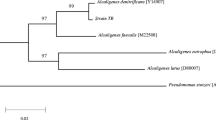Abstract
Objectives
To synthesize hydrazine (N2H4) from ammonium and hydroxylamine (NH2OH) using an anaerobic ammonium oxidation (anammox) bacterium, Candidatus Kuenenia stuttgartiensis.
Results
K. stuttgartiensis cells were anoxically cultivated with the addition of ammonium (2 mM) and NH2OH (1–100 mM) at pH 6–10.5, and 4–65 °C to examine the favorable cultivation conditions for N2H4 production. The influence of NH2OH concentration was more prominent than that of pH and temperature, and NH2OH concentration higher than 1 mM deteriorated N2H4 yields significantly. The following conditions were found to be favorable for N2H4 production using K. stuttgartiensis cells: pH 9, 38 °C, and < 1 mM NH2OH. In a continuous-feed system operated at these conditions, K. stuttgartiensis cells produced N2H4 with a maximum concentration of 0.65 mM, which is the highest N2H4 concentration previously reported in biological processes.
Conclusions
Optimal cultivation conditions for K. stuttgartiensis for N2H4 production were successfully determined, and the present study is the first to document potential biological N2H4 production using anammox bacteria.



Similar content being viewed by others
References
Ali M, Oshiki M, Awata T, Isobe K, Kimura Z, Yoshikawa H, Hira D, Kindaichi T, Satoh H, Fujii T, Okabe S (2015) Physiological characterization of anaerobic ammonium oxidizing bacterium Candidatus Jettenia caeni. Environ Microbiol 17:2172–2189
Frear DS, Burrell RC (1955) Spectrophotometric method for determining hydroxylamine reductase activity in higher plants. Anal Chem 27:1664–1665
Kartal B, Rattray J, van Niftrik LA, van de Vossenberg J, Schmid MC, Webb RI, Schouten S, Fuerst JA, Damsté JS, Jetten MSM, Strous M (2007) Candidatus ‘Anammoxoglobus propionicus’ a new propionate oxidizing species of anaerobic ammonium oxidizing bacteria. Syst Appl Microbiol 30:39–49
Kartal B, van Niftrik L, Rattray J, van de Vossenberg JLCM, Schmid MC, Damsté JS, Jetten MSM, Strous M (2008) Candidatus ‘Brocadia fulgida’: an autofluorescent anaerobic ammonium oxidizing bacterium. FEMS Microbiol Ecol 63:46–55
Kartal B, Keltjens JT (2016) Anammox biochemistry: a tale of heme c proteins. Trends Biochem Sci 41:998–1011
Maalcke WJ, Reimann J, de Vries S, Butt JN, Dietl A, Kip N, Mersdorf U, Barends TRM, Jetten MSM, Keltjens JT, Kartal B (2016) Characterization of anammox hydrazine dehydrogenase, a key N2-producing enzyme in the global nitrogen cycle. J Biol Chem 291:17077–17092
Oshiki M, Awata T, Kindaichi T, Satoh H, Okabe S (2013) Cultivation of planktonic anaerobic ammonium oxidation (anammox) bacteria by using membrane bioreactor. Microbes Environ 28:436–443
Oshiki M, Ali M, Shinyako-Hata K, Satoh H, Okabe S (2016a) Hydroxylamine-dependent anaerobic ammonium oxidation (anammox) by “Candidatus Brocadia sinica”. Environ Microbiol 18:3133–3143
Oshiki M, Satoh H, Okabe S (2016b) Ecology and physiology of anaerobic ammonium oxidizing (anammox) bacteria. Environ Microbiol 18:2784–2796
Oshiki M, Masuda Y, Yamaguchi T, Araki N (2018) Synergistic inhibition of anaerobic ammonium oxidation (anammox) activity by phenol and thiocyanate. Chemosphere 213:498–506
Patil KC, Rattan TM (2014) Inorganic hydrazine derivatives: synthesis, properties and applications, 1st edn. Wiley, New York
Shimamura M, Nishiyama T, Shigetomo H, Toyomoto T, Kawahara Y, Furukawa K, Fujii T (2007) Isolation of a multiheme protein with features of a hydrazine-oxidizing enzyme from an anaerobic ammonium-oxidizing enrichment culture. Appl Environ Microbiol 73:1065–1072
Schmidt EW (2000) Hydrazine and its derivatives: preparation, properties, applications, 2nd edn. Wiley interscience, New York
Tiensomjitr K, Noorat R, Chomngam S, Wechakorn K, Prabpai S, Kanjanasirirat P, Pewkliang Y, Borwornpinyo S, Kongsaeree P (2018) A chromogenic and fluorogenic rhodol-based chemosensor for hydrazine detection and its application in live cell bioimaging. Spetrochim Acta A 195:136–141
Tsushima I, Ogasawara Y, Kindaichi T, Satoh H, Okabe S (2007) Development of high-rate anaerobic ammonium-oxidizing (anammox) biofilm reactors. Water Res 41:1623–1634
van de Graaf AA, de Bruijn P, Robertson LA, Jetten MM, Kuenen JG (1996) Autotrophic growth of anaerobic ammonium-oxidizing micro-organisms in a fluidized bed reactor. Microbiology 142:2187–2196
van de Graaf AA, de Bruijn P, Robertson LA, Jetten MM, Gijs Kuenen J (1997) Metabolic pathway of anaerobic ammonium oxidation on the basis of I5N studies in a fluidized bed reactor. Microbiology 143:2415–2421
van der Star WRL, van de Graaf MJ, Kartal B, Picioreanu C, Jetten MSM, van Loosdrecht MCM (2008) Response of anaerobic ammonium-oxidizing bacteria to hydroxylamine. Appl Environ Microbiol 74:4417–4426
Watt GW, Chrisp JD (1952) A spectrophotometric method for the determination of hydrazine. Anal Chem 24:2006–2008
Acknowledgements
This work was supported by JSPS KAKENHI (Grant Nos. 19K05805, 17K15305, 16H02371, and 16H04442); the Steel Foundation for Environmental Protection Technology (Grant No. Water quality-21); and 1st IMRA JAPAN award. Part of this work was conducted at the Chitose Institute of Science and Technology, supported by the Nanotechnology Platform Program (Molecule and Material Synthesis) of the Ministry of Education, Culture, Sports, Science and Technology (MEXT), Japan.
Author information
Authors and Affiliations
Contributions
All authors contributed to the study conception and design. Material preparation was performed by MO, IK, KO, and TI. Data collection and analysis were performed by MO and KY. The first draft of the manuscript was written by MO and all authors commented on previous versions of the manuscript. All authors read and approved the final manuscript.
Corresponding author
Ethics declarations
Conflict of interest
The authors declare that they have no conflicts of interest.
Ethical approval
This study does not include any studies with human participants or animals performed by any of the authors.
Additional information
Publisher's Note
Springer Nature remains neutral with regard to jurisdictional claims in published maps and institutional affiliations.
Rights and permissions
About this article
Cite this article
Oshiki, M., Yamada, K., Kato, I. et al. Biosynthesis of hydrazine from ammonium and hydroxylamine using an anaerobic ammonium oxidizing bacterium. Biotechnol Lett 42, 979–985 (2020). https://doi.org/10.1007/s10529-020-02865-6
Received:
Accepted:
Published:
Issue Date:
DOI: https://doi.org/10.1007/s10529-020-02865-6




